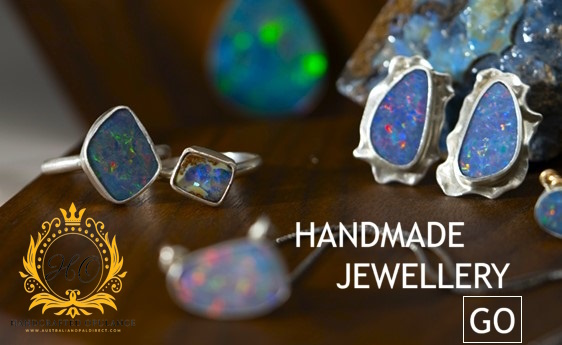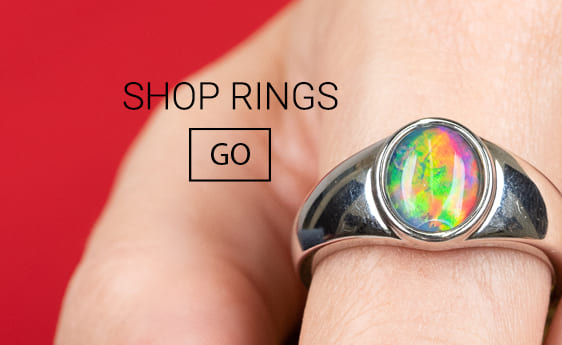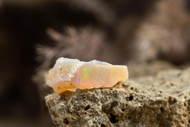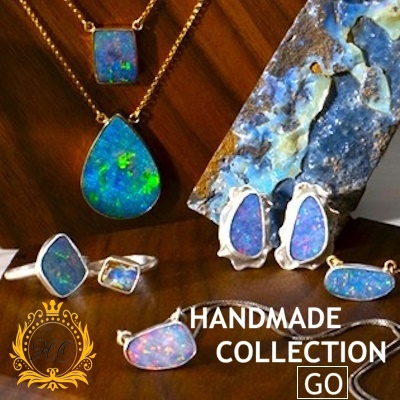Opal Stone 101: History, Symbolism, and Uses
Posted by Australian Opal Direct on 2nd Nov 2023
Welcome to the entrancing world of Opal stones, where rich history, profound symbolism, and versatile uses come together. Known for their dazzling play of colors, Opals are no ordinary gemstones. They are Precious Gemstones that canvas nature's art, encapsulating the beauty of the cosmos with every color of the rainbow in each iridescent shimmer.
Opal's allure goes beyond its visual charm, extending to its intriguing history and profound symbolism. Throughout the ages, this gemstone has been treasured for the unique qualities and conversation it sparks, aligning perfectly with the desire for luxury combined with authenticity.
As we explore the fascinating narrative of Opal stones, you will discover the meaning, origins, and uses associated with Opals, bolstering your appreciation for this exquisite jewel.
Unveiling the Uniqueness of Opals
Opals stand distinct in the world of precious gemstones, demonstrating an individuality that sets them apart. Unlike many gemstones that derive their value primarily from color, clarity, cut, and carat, the allure of Opals is founded in a mesmerizing phenomenon known as "play-of-color."
- Opals' unique "play-of-color" creates a kaleidoscopic dance of colors within the gem.
- These colors dance and flicker when the Opal is moved.
- Opal formation is notably distinct from gemstones like Diamonds, Emeralds, and Rubies.
- These precious gems develop as crystalline structures deep within the Earth's mantle.
- Unlike Opals, they form under high pressure and temperature conditions.
- Opals' unique origins contribute to their individuality and appeal


Lastly, while other gemstones are typically enhanced or treated to improve their appearance, Opals are most appreciated when worn in their natural state. Their charm lies in their organic, untouched allure, which is free from artificial color treatments.
- Opals' natural beauty resonates with modern consumers.
- They attract both seasoned gem aficionados and newcomers.
- Opals are favored for their authenticity and allure.
The History of Opal Stones
“The chronicle of Opal stones is as captivating as their kaleidoscopic brilliance, with a history that harks back to antiquity. This extraordinary gem, graced with a spectral dance of colors, has always held a unique place in many cultures around the globe.”
From the ancient Romans, who valued it as a symbol of hope and purity, to the Indigenous Australians who assigned cosmic significance to it, the Opal stone's rich historical tapestry is interwoven with legends, folklore, and reverence.
As we delve into the annals of its storied past, we unravel the mysteries that cement the Opal's status as a gemstone par excellence.
Origins of Opals
Opal stones owe their birth to a fascinating geological process that has taken place over millennia. These gemstones are a product of various factors, including the location of the ancient inland sea and seasonal rains that drenched dry ground in Opal-bearing regions such as Australia's desert Outback (where the world-famous Black Boulder Opal is sourced), among many other factors.
- Water seeped into ancient underground rock, transporting dissolved silica downward.
- During dry spells, water evaporated, depositing solid silica in rock crevices.
- Silica particles accumulated over time.
- These particles compressed to form Opals.
- Opals' unique origin sets them apart from other gemstones.

Over the course of time, these silica particles compacted and hardened to form Opals. This incredible process makes each Opal a testament to the beauty and complex design found within the natural world.
Opal in Ancient Civilizations
Opal has been a cherished gemstone in various ancient civilizations, lauded not just for its aesthetic appeal, but also its symbolic significance. These ancient civilizations attributed deep meanings to Opal, often linking it with their cultural, religious, and philosophical beliefs.
In Ancient Greece, Opals were associated with prophecy and the oracles. The Greeks believed that Opal bestowed the power of foresight and protection from diseases. They christened the stone "Opallios," meaning "to see a change," which was an apt description of the Opal's unique ability to refract and reflect light.
In ancient India, Opals were celebrated as the Goddess of the Rainbow, petrified by flight. This metaphorical narrative was inspired by the Opal's kaleidoscopic vibrancy, which mimics the multi-hued grandeur of a rainbow.
The ancient Romans sourced Opals from the far reaches of the East and were utterly captivated by this otherworldly gem. To them, Opal was the "Cupid Paederos," translating to "child as beautiful as love."
The Roman scholar Pliny described Opal as having the "fire of the carbuncle, the brilliant purple of amethyst, and the sea-green of the emerald, all shining together in incredible union."
In the civilizations of the Mesoamerican region, the Aztecs utilized Opal for ritualistic ceremonies and adorned their intricate mosaics and artifacts with Opal, showcasing the gemstone's prominent role in their artistic and spiritual endeavors.
Legends and Lore
The lore surrounding Opal stones is as multifaceted as the gemstone itself, painting a vivid picture of human sentiment and cultural resonance throughout history.
A notable legend hails from ancient Rome, where Opals were seen as the most powerful and beneficial of all gemstones because they carried the colors of all other gems inside.
- Romans associated Opals with hope and purity.
- They believed Opals could grant the gift of foresight.
- Opals held a special place in Roman culture.
- Opal was considered a symbol of positivity and spiritual insight.
- Roman admiration for Opals contributed to their enduring popularity.
- Opals were valued for their symbolic significance in Roman society.

In Arabian folklore, Opals were thought to have fallen from the heavens in flashes of lightning, meaning the Arabs attributed the stone's fiery play-of-color to a celestial origin. For these ancient peoples, the Opal possessed an aura of divine mystery and heavenly magic.
Contrarily, during the Middle Ages, Opal was alleged to make the wearer invisible, earning it a reputation as a "thief's stone." However, it was also seen as a guardian of eyesight and a protective amulet that could ensure a safe passage through stormy seas.

Indigenous Australian lore held Opals in the highest regard. For the Aboriginal people…
- Opals were considered a tangible fragment of the rainbow earth.
- They held spiritual significance in Indigenous Australian culture.
- Opals were intertwined with creation myths.
- The creator was believed to have descended on Earth on a rainbow.
- Opals were seen as a gift from the creator symbolizing their presence.
- This cultural belief reflects the deep spiritual connection to Opals.
Each of these legends and pieces of folklore contributes to the rich tapestry of meanings and uses associated with Opal stones, revealing their intrinsic link to human history, spirituality, and the natural world.
Opal in Modern Times
In the modern era, the allure of the Opal stone continues to captivate. As scientific understanding has evolved, so too has our knowledge of this magnificent gemstone. Today, Australia is recognized as the world's largest producer of Opal (representing a whopping 95% of the global supply!), and its vibrant, high-quality stones are admired on a global scale.
The discovery of Opal fields in regions such as Queensland, Lightning Ridge, and Coober Pedy has fueled Australia's Opal mining industry. Notably, the "Black Boulder Opal," known for its dark body tone and vibrant play of color, is a highly prized variety that hails from these regions.
In contemporary culture, Opal has become a symbol of creativity, inspiration, and artistic expression. Its myriad colors seem to fire the imagination, leading many to associate it with creativity and inspiration.
Today, designers and artisans often incorporate Opal into their creations, its iridescent play of color adding an element of intrigue and depth to their designs. Its unique color patterns ensure that no two Opal pieces are exactly alike, making each piece of Opal jewelry a distinct work of art.
Moreover, Opal has also maintained its spiritual significance. Many people today ascribe healing properties to gemstones, and Opal is often sought for its purported ability to instill the wearer with a sense of calm and balance.
For those who believe in chakras, the Opal is primarily associated with the sacral chakra (though individual varieties of Opal may be associated with other chakras) and thus is believed to help bring immoderate desires into balance.
On a similar note, the Opal has found a special place in modern alternative therapies and holistic healing practices. Reiki practitioners, crystal healers, and others involved in energetic therapies often utilize Opal for its perceived energy-enhancing properties.

As we move forward into the future, the fascination with Opals shows no signs of waning. The Opal stone's compelling dance of light continues to evoke a sense of wonder, enchanting us with its magic and reminding us of its amazing journey through human history.
Symbolism of the Opal Stone
“Opal has long been steeped in symbolism and lore that permeates various cultures and timelines. The myriad hues reflected in each Opal are a palette for the imaginative mind, painting images of hope, creativity, and fiery passion.”
This section continues to delve into the rich symbolism of the Opal stone, exploring layers of meaning that span from its association with divine prophecy and purity in ancient civilizations to its modern-day connections with inspiration, emotional balance, and holistic healing.
As we delve deeper, we unravel the intricate tapestry of beliefs and meanings that elevate this gemstone from a mere object of aesthetic appeal to a profound emblem of spirituality, love, and joy.
The Meaning of the Opal Stone
In the realm of gemstones, the Opal is truly unique because of the way it encapsulates a world of meanings within its fiery dance of colors. Its very name, derived from the Greek word "Opallios," resonates with the essence of vision - the ability "to see a change."
- Opal's ability to reflect a spectrum of hues signifies its versatility.
- The beauty and elegance of Opals can hold different meanings in various contexts.
- Opal meanings encompass spiritual attributes.
- They enhance self-worth and self-esteem.
- Opals facilitate the expression of one's true self.
- Opals are known for bringing lightness to one's spirit.
- They encourage spontaneity and authenticity.
- Opals are linked to a deeper understanding of one's true nature.


From a healing perspective, Opals are often linked with calming and soothing energies that are believed to alleviate stress while also promoting feelings of tranquility and peace. In particular, the White Opal is considered a bearer of hope, purity, and luck.
In the context of creativity and inspiration, the Opal is credited with sparking the imagination and inspiring the artistic mind. Its kaleidoscope of colors stirs up creativity, making it a favorite talisman for artists, writers, musicians, and other creative professionals
In essence, the meanings of the Opal stone are as layered and multi-faceted and layered as the gem's physical form. From invoking feelings of love and passion to inspiring creativity and promoting a sense of calm, the Opal truly is a gemstone of diverse meanings and uses.
Birthstone Symbolism
Opal also holds a special significance as a birthstone. Traditionally, it is associated with the month of October, symbolizing the calm of autumn and the fiery hues of the changing leaves. This connection imbues the Opal with the qualities of tranquility, balance, and transformation, mirroring the seasonal shift that October represents.
Those born in this month are sometimes associated with the attributes of creativity, faith, and confidence, which the Opal stone thus embodies. The Opal's shifting play-of-color is thought to bring out the inner radiance and multilayered personality of the October-born, illuminating their path with inspiration and artistic expression.
As a birthstone, Opal is not merely a token of one's time of birth, but a personal talisman that adds symbolic richness to the life of its wearers.

The Opal as a Stone of Inspiration
In addition, the Opal stone is widely revered as a source of inspiration. Its unique array of colors sparks the imagination, acting as a muse for artists, writers, designers, and dreamers. Every glance at an Opal unveils a different pattern, a different dance of light, and a different spectacle of color, each symbolizing the infinite possibilities of creativity.
The stone's vibrant Opalescence is indeed a visual metaphor for the boundless potential of the human imagination. For this reason, the benefits of Opal stones aren't just aesthetic or materialistic. They are also deeply intellectual and spiritual, inspiring a sense of wonder and a venture into the realms of creativity.
As a result, every piece adorned with Opal becomes an individualistic expression of art that resonates with the wearer's personal style and creative outlook. Since no two Opals exhibit the exact same color play, each piece of Opal jewelry retains its distinct charm, mirroring the wearer's uniqueness.
Breaking Down the Meanings of Different Kinds of Opals
Just as every Opal is one-of-a-kind, so too are the meanings and symbolism associated with specific Opals of differing colors.
Common Opals vs. Precious Opals
The Opal family can be divided into two categories: Common Opals and Precious Opals. Common Opals, as their name suggests, are relatively more abundant and do not exhibit the very dramatic characteristic play-of-color that Opals are renowned for. A common Opal is often called “Potch Opal,” still exhibiting amazing colors but with a less dramatic “play of color.”
On the other hand, Precious Opals are a spectacle to behold, displaying an impressive array of colors that shift and change with light and viewing angle. This mesmerizing attribute, known as "play of color," arises from the precise arrangement of tiny silica spheres within the Opal's structure.


The rarity and unique beauty of Opals make them highly desirable and esteemed in the world of gemstones. If you can only own one precious stone, you should wear Opal.
Boulder Opal
Boulder Opals, formed within ironstone boulders, retain parts of the surrounding rock matrix as part of their unique structure. These earthy qualities symbolize grounding and stability, while the vibrant flash of colors in a boulder Opal is believed to inspire spontaneity and spark creativity. This encourages wearers to exercise the freedom to express their true selves.

Black Opal

The black Opal, with its dark body tone and electrifying play of colors, is considered the most valuable and desirable of all Opals. Its blackness is associated with depth, strength, and energy, and it is often linked with unlocking hidden feelings, buried emotions, and long-forgotten memories.
White Opal
White Opals, also known as light or milk Opals, are the most common type of Opal. They have a white, milky base color with a mesmerizing play of colors on top. White Opals symbolize purity, innocence, and hope.
These Opals are thought to help clarify thoughts, emotions, and actions. Their light base gives their play-of-color an ethereal, dream-like quality that is typically associated with spiritual growth.

Blue Opal

With their stunning azure hues, blue Opals evoke images of the tranquil sea and expansive sky. Because of this, they symbolize communication, serenity, and spiritual healing. The calm, soothing shades of blue are thought to encourage open dialogue, facilitate understanding, and stimulate creative expression, aligning perfectly with the Opal's reputation as a stone of inspiration.
Its blue color, often associated with spiritual practices, evokes a sense of peace and tranquility, aiding in relaxation and stress relief. As a symbol of hope, blue Opals are often used in meditation and spiritual practices to enhance clarity, calm the mind, and promote a sense of serenity and inner peace.
Green Opal
As the name would suggest, green Opals present an enchanting spectrum of vibrant green tones that capture the essence of lush landscapes and the vibrancy of nature. They are often associated with rejuvenation, emotional recovery, and the invigoration of one's love life.
The green Opal serves as a symbol of life's constant changes and the enduring cycle of rebirth, growth, and renewal. As such, it is deeply connected with healing, not just in a physical sense, but emotionally and spiritually as well.
The verdant hues of the green Opal are often linked with luck, prosperity, and abundance, making it a cherished companion for those seeking forward progress in their lives.

Fire Opal

Fire Opals, which are red Opals distinguished by their vibrant scarlet play of color, are among the rarest and most sought-after Opals. Their fiery red hues evoke images of burning passion, love, and desire, altogether symbolizing a dynamic, bold spirit.
In the realm of color symbolism, red is deeply associated with energy, strength, and determination. This gemstone serves as a constant reminder of the burning passion within us, inspiring us to pursue our dreams with unwavering dedication.
Purple Opal
Purple Opals, characterized by their magnificent hues that range from lavender to deep plum, are a captivating spectacle similar to the mystery and charm of twilight skies. These stunning purple Opals carry with them a sense of spirituality, intuition, and inner strength.
Purple, traditionally a royal color, is associated with nobility, luxury, and power. As items of jewelry, purple Opals stand out as a vibrant expression of the wearer's mystical, intuitive, and regal nature, imparting a unique sense of elegance and luxury.

Crystal Opal

Crystal Opals are transparent to semi-transparent Opals that showcase a rich play of color. They are associated with clarity, insight, and transformation. Many believe that crystal Opals hold the power to enhance one's psychic abilities, strengthen intuition, and promote spiritual growth.
As a result, they are used in meditation and spiritual practices to enhance one's intuition and clear vision of the self. Wearing a piece of crystal Opal jewelry can act as a constant reminder to embrace inner wisdom, trust one's instincts, and embark on an inward journey toward self-discovery.
Rainbow Opal
Rainbow Opals, also referred to as galaxy Opals, are a spectacle to behold. They captivate with their abundant play of color, displaying all the hues of the rainbow in an otherworldly dance of light. Much like galaxies, each rainbow Opal is unique, with a distinct pattern of colors and flashes.
The magic of the rainbow Opal resides not only in its breathtaking beauty but also in the meaning of the Opal stone, which is as layered and profound as the stone's vibrant palette.
Attributed with the power to foster hope, confidence, and creativity, rainbow Opals have become a symbol of joy, positivity, and artistic inspiration. Their varied colors are believed to stimulate the imagination, making them a popular choice for individuals in creative professions.

In conclusion, the meanings and symbolism of Opals extend far beyond their dazzling physical appearance. Each variety, with its unique color and structure, imparts distinctive energies, vibes, and symbolism, making each Opal a truly enchanting gemstone with layered levels of significance to explore.
The Meanings Associated With Different Opal Structures: Singles, Doublets, and Triplets
Opal structures, specifically solids, doublets, and triplets, also carry significant meanings. This unsurprisingly adds another layer to the Opal's rich symbolism and use.
Solid Opal
A solid Opal, as the name suggests, is a single piece of Opal cut and polished for use in jewelry. This form is the most natural representation of the Opal.
Single Opals are often seen as the "purest" form of the stone, making them the embodiment of nature's authenticity, individuality, and unadorned beauty.
Doublet Opal
A doublet Opal, meanwhile, consists of two layers: a thin slice of precious Opal adhered to a black backing, often made of potch (non-precious Opal), glass, or basanite. The black backing enhances the Opal's color, making it more vibrant and noticeable.
Symbolically, doublet Opals represent enhancement, transformation, and adaptability. Just as the backing layer enhances the stone's color, wearing a doublet Opal may symbolize one's desire or effort to bring about positive changes and improvements in life.
Triplet Opal
A triplet Opal is similar to a doublet but adds a third, clear layer on top (usually made of quartz or glass) to protect the Opal and give it a domed appearance, which further magnifies the stone's color.
The triplet Opal embodies protection, preservation, and amplification. It signifies the value of safeguarding a person's precious qualities while also magnifying and showcasing one's unique attributes to the world.
In short, the structure of an Opal, whether it's a single, doublet, or triplet, contributes to its overall symbolism and meaning. Each structure, with its unique characteristics and formation, resonates with its wearer in a variety of inspiring ways.
The Many Uses of Opal Stones

Opals are more than just mesmerizing jewels; their uses extend far beyond the realm of ornamental adornment. Acting as a symbol of creativity and a token of inspiration, Opals find their way into various aspects of life thanks to their unique properties and rich symbolism.
They serve as birthstones, talismans of love, tokens of hope, and catalysts for creativity, their multifaceted symbolism making them ideal for each of these uses. The following section discusses the wide-ranging uses of Opal stones in depth, from their role in jewelry making and spiritual practices to their significance in cultural traditions and even healing therapies.
Jewelry and Adornment
In the world of jewelry, Opals occupy a distinctive place. Their stunning play of colors and unique patterns make each Opal piece one-of-a-kind, defining the heart of bespoke luxury. Opals can be cut and polished into a variety of shapes and sizes, making them versatile additions to all kinds of jewelry, from rings and necklaces to bracelets and earrings.
The characteristics of Opals lend an eye-catching allure to any piece, transforming it into a wearable work of art and an emblem of elegance and sophistication.
Opal rings, often set with diamonds or other precious gemstones, are symbolic tokens of love and commitment. This makes an Opal ring an ideal choice for an engagement ring or anniversary gift. Necklaces and pendants featuring Opal become not just accent pieces but conversation starters, their dazzling array of colors reflecting the wearer's individuality and taste.


In addition to traditional jewelry, Opals can also be incorporated into brooches, hair accessories, and even body jewelry, further attesting to their versatility and widespread appeal. Whether set in gold for a luxurious feel or complemented with silver for a sleeker, modern look, Opals elevate every piece of jewelry with their iridescence and unique beauty.
These gems are also often used in watchmaking, where Opal dials add a unique and captivating element of surprise to the timepiece. Custom-made Opal cufflinks are another popular choice, adding a touch of subtle elegance to men's fashion.
A piece of Opal jewelry does more than just adorn; it reveals a sense of style, tells a story, and invites the viewer into a world of color and imagination.
Healing and Therapeutic Uses
In the realm of healing and therapy, Opal stones are highly valued for their perceived restorative and calming properties. The stone's vibrant energy is said to restore the body's balance and promote a sense of peace and tranquility.
As a healing stone, Opal is believed to enhance consciousness and eliminate negative energies, making it a powerful tool for meditation and spiritual practices. It has been credited with the ability to heal emotional distress, as well as aid in overcoming fears and insecurities.
Traditional folklore also attributes the Opal with physical healing capabilities. It's believed to regulate insulin production, purify blood and kidneys, and alleviate symptoms associated with disorders of the eye. In some cultures, Opal is used as a protective charm during childbirth because it is thought to safeguard both mother and child.
Moreover, the Opal stone may benefit people suffering from depression and anxiety by promoting a positive outlook and fostering feelings of optimism and hope. Its radiant energy is said to inspire love and passion, enhance self-worth, and boost creativity and self-expression.
In therapeutic settings, Opal is often used in the practice of crystal healing. With its soothing energy, it's said to bring about a state of calm and relaxation, helping to alleviate stress and promote emotional well-being.

Opal Stone Benefits in Various Cultures
In various cultures across the globe, the Opal stone is revered and held in high esteem for its perceived benefits and powers. The stone's rich history is deeply intertwined with numerous cultural traditions, each attributing unique symbolism and benefits to the gemstone.
Aboriginal Australian Traditions
In indigenous Australian lore, Opals are believed to carry the essence of the creator, embodying a spiritual connection to the land. They are considered sacred relics that hold the power of dreams and visions while symbolizing the infinite possibilities of the cosmos.

Ancient Greek Beliefs

The ancient Greeks associated Opal with prophecy and foresight. They believed that Opals bestowed their owners with the power of prediction and protection from disease. The Opal was thought to bring its owner luck, hope, and purity.
Roman Cultural Significance
In ancient Rome, the Opal was a symbol of hope, faith, and truth. It was believed to possess all the virtues of the various gemstones whose colors were represented in its spectral color play, making the Opal a very valuable and sought-after stone.

Arab Traditions

Arabic cultures believed that Opals fell from the sky during thunderstorms and were filled with lightning. They were consequently seen as highly lucky and protective stones.
Asian Beliefs
In the East, particularly in India and parts of Asia, Opals have historically been associated with love, passion, and desire, symbolizing fidelity and assurance.

Other Cultural Beliefs
In some cultures, Opals are considered healing stones that restore harmony to the mind, body, and spirit. They are believed to inspire creativity, enhance self-confidence, and encourage positive change. In modern Western culture, the Opal stone is also the birthstone for the month of October, symbolizing hope, innocence, and creativity.
From these various cultural perspectives, the Opal is much more than a gemstone. It is a symbol of hope, faith, creativity, and healing, illuminating our lives with its vibrant spectrum. The widespread cultural significance of Opal stones underscores their enduring charm and universal appeal, making them truly global treasures.
Procuring Quality Opal Stones
The journey to owning a piece of Opal jewelry begins with procuring quality Opal stones. This endeavor is not just about aesthetics and value, but it also carries ethical significance. High-quality Opals are a testament to nature's artistry with their rich, vivid play of color, but it's imperative to ensure they are sourced responsibly.
Ethical sourcing practices play a crucial role in preserving the environment, supporting the communities involved in mining, and maintaining the long-term viability of the Opal industry. Therefore, acquiring ethically sourced, quality Opal stones is not only an investment in a beautiful gem but also a commitment to sustainability and fair trade.

Ethical Sourcing of Opals
What is Ethical Sourcing of Opals?
Ethical sourcing of Opals is the process of ensuring that the Opals are extracted, processed, and marketed in a manner that is both responsible and sustainable. It means that the mining of these precious gems adheres to fair labor practices, respects the rights of indigenous communities, and minimizes environmental degradation.
It's about making sure that the journey of the Opal, from the earth to your jewelry box, is characterized by fairness, respect, and sustainability.
How to Find a Seller That Uses Ethical Sourcing
Finding a seller that values and practices ethical sourcing can seem daunting, but there are several factors that you can consider.
Firstly, look for sellers who openly share information about their sourcing practices. Transparency is a key indicator of ethical sourcing. Sellers who are committed to ethical sourcing will typically provide details about where their Opals come from and how they are mined.
Secondly, consider the seller's engagement with the communities where the Opals are sourced. Ethical sellers often invest in the communities in which they operate by contributing to local infrastructure, education, and well-being.
Lastly, consider the environmental impact. Ethically sourced Opals are mined and processed in a manner that minimizes harm to the environment. Sellers committed to ethical sourcing will be able to demonstrate how they are minimizing their environmental footprint.
In sum, sourcing Opals ethically is about more than just purchasing a gemstone; it's about supporting practices that respect human rights, foster community development, and protect our planet while embracing it.
Ensuring High Quality and Uniqueness
Why Quality Counts
Quality is also paramount when it comes to purchasing Opal stones. High-quality Opals are characterized by a vibrant play of color, clarity, pattern, and overall uniqueness. These traits not only enhance the beauty and allure of the stone but also significantly impact its value.
A quality Opal is an embodiment of luxury and elegance, exuding an ethereal charm that captivates and enchants. It serves as a true conversation piece by reflecting the wearer's impeccable taste and appreciation for nature's artistry.

Finding Stand-Out Gems
To ensure the quality and uniqueness of the Opal you purchase, you should follow some key guidelines.
First of all, understand the different types of Opals. Each type, be it Boulder Opal, White Opal or Black Opal has distinct characteristics and grading factors. Familiarize yourself with these factors so you can make an informed decision when buying.
Next, seek professional advice. Reputed jewelers or certified gemologists have profound knowledge about gemstones and can provide helpful insight into the quality of an Opal.
Finally, if possible, hold the stone in your hand and look at it in different lighting conditions. A high-quality Opal will display a captivating play of color in all lighting conditions. Its unique patterns and color intensity are what make each Opal unique. Investing time in this step is crucial.
Finding a unique, high-quality Opal stone means finding a gem that shows off your combination of sophistication, discernment, and an appreciation for beauty in its purest, most natural form.
Conclusion
In the realm of gemstones, Opals hold an enigmatic allure and charm that is unmatched. As you embark on your journey to own one of these radiant gems, remember that quality, ethical sourcing, and uniqueness should be your guiding principles.
For those in search of these exceptional stones, Australian Opal Direct offers a wide selection of ethically sourced, high-quality Opal jewelry items, with each piece possessing a unique play of color and charm. Let your Opal be more than just a gemstone - let it be a conversation piece, a symbol of creativity, and a beacon of luxury and elegance.












